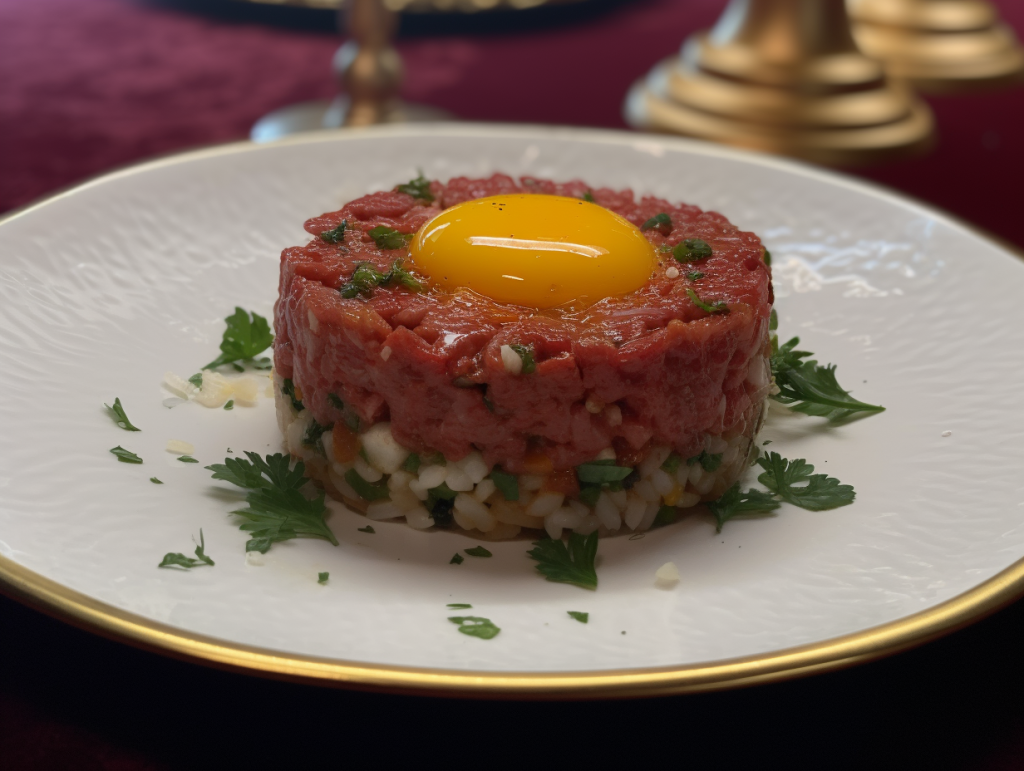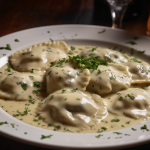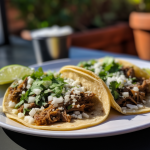Yukhoe, also known as Korean steak tartare, is a dish that has gained immense popularity in recent years, both in Korea and across the world. It is a dish made from the highest quality beef, typically tenderloin, that is thinly sliced and mixed with a variety of seasonings to create a rich, savory flavor. The seasonings typically include soy sauce, sugar, garlic, sesame oil, and ground black pepper.

One of the unique aspects of yukhoe is the way it is presented. The beef is arranged in a circular shape on a plate, with a raw egg yolk in the center. Around the beef, various toppings and garnishes are placed, such as julienned Asian pear, sliced green onion, and toasted pine nuts. These toppings not only add flavor and texture but also provide a visually stunning presentation.
Yukhoe is a dish that is both refreshing and indulgent, with a depth of flavor that satisfies even the most discerning palate. It is typically served as an appetizer or a main course and is often accompanied by rice or other side dishes. With its unique flavor and presentation, yukhoe has become a staple of Korean cuisine and a must-try dish for anyone looking to explore new and exciting flavors.
Print
Yukhoe (Korean Steak Tartare)
Ingredients
- 6–7 oz filet mignon medallion (frozen)
- 1 clove Garlic (finely chopped)
- 1 slice Onion (finely chopped)
- 1 Tbsp Sesame oil
- 1/2 Tbsp soy sauce
- 1/2 Tbsp gochujang
- 1/2 Tbsp honey
- 1 egg yolk
- 1/4 Asian pear
- 6 pine nuts
- chives or parsley (garnish)
- baguette slices (thinly cut)
Instructions
- Defrost the filet mignon in the refrigerator overnight. If it is completely defrosted, return it to the freezer until almost frozen so that it is easier to cut. Chop the filet mignon into small pieces with a sharp knife.
- Marinade. Finely chop the garlic and onion. Mix with gochujang, soy sauce, sesame oil, and honey.
- Salad. Finely chop the asian pear. Or alternately, slice the asian pear into strips and serve on the side.
- Steak Tartare. Mix the ground meat with the marinade. Use a food ring or a round cookie cutter to mould the chopped Asian pear into a circle, then the steak on top of it. If using a cookie cutter you may need to stack them.
- Garnish. Wash the egg and use it to create an indentation in the middle of the steak. Crack open the egg, discard the egg white, and place the egg yolk in the indentation. Arrange the pine nuts in a circle around the egg. Garnish with chives or parsley. Carefully remove the ring.
- Baguette. Cut thin slices from a baguette and toast in a broiler until slightly hard.
The history of yukhoe dates back to ancient Korea when beef was considered a luxury item, only available to the wealthy. The dish was originally called hwae, which means raw fish in Korean, and was made with raw fish that was marinated in various seasonings. However, over time, beef became more readily available, and the dish evolved into the yukhoe we know today.
One of the most important aspects of yukhoe is the quality of the beef used. Only the highest quality cuts of beef are used, typically tenderloin, which is then hand-cut into thin slices to ensure the perfect texture. The beef is then mixed with the seasonings and allowed to marinate for several hours to enhance the flavor.
One of the key ingredients in yukhoe is garlic, which is used liberally in the dish to give it a pungent, spicy flavor. In traditional Korean medicine, garlic is believed to have many health benefits, including its ability to lower blood pressure and boost the immune system.
Another important ingredient in yukhoe is sesame oil, which is used to add a nutty, savory flavor to the dish. Sesame oil is a common ingredient in Korean cuisine and is believed to have many health benefits, including its ability to lower cholesterol and improve heart health.
The garnishes used in yukhoe not only add flavor and texture but also provide a visually stunning presentation. The julienned Asian pear is a particularly important garnish, as it adds a sweetness that complements the savory flavor of the beef. The sliced green onion and toasted pine nuts add a subtle crunch and nuttiness to the dish, rounding out the overall flavor profile.
One of the unique aspects of yukhoe is the raw egg yolk that is served in the center of the beef. The yolk is mixed with the beef and seasonings to create a rich, creamy sauce that coats the beef and enhances the overall flavor. While some may be hesitant to eat raw egg yolk, it is an essential part of the dish and adds to the overall experience.
Yukhoe has become a beloved dish in Korea and has gained popularity in other parts of the world in recent years. Its unique flavor and presentation make it a must-try dish for anyone interested in exploring new and exciting flavors. While it may seem intimidating at first, yukhoe is a dish that is well worth the effort and is sure to leave a lasting impression.



